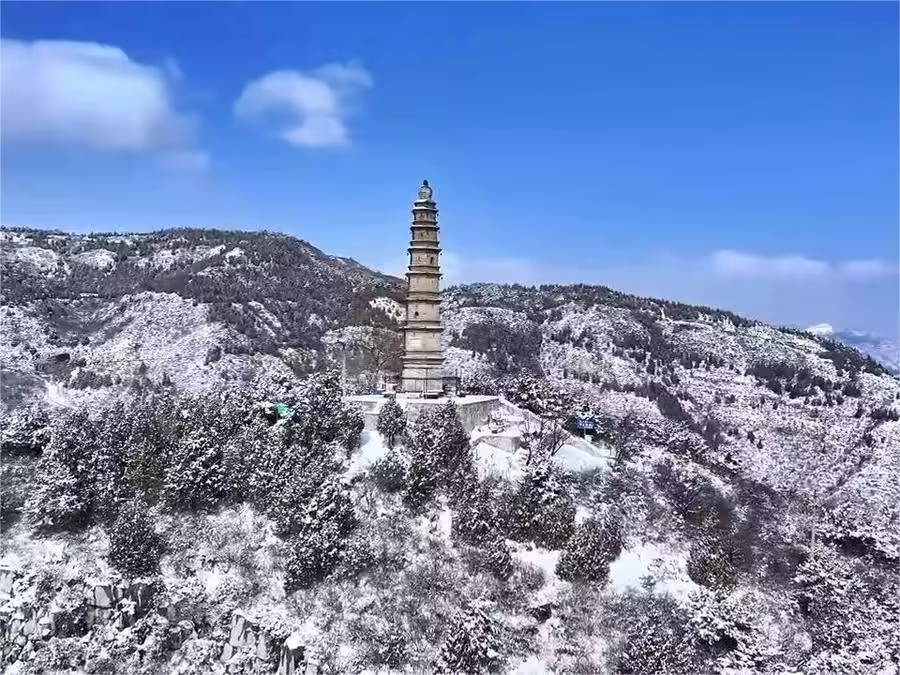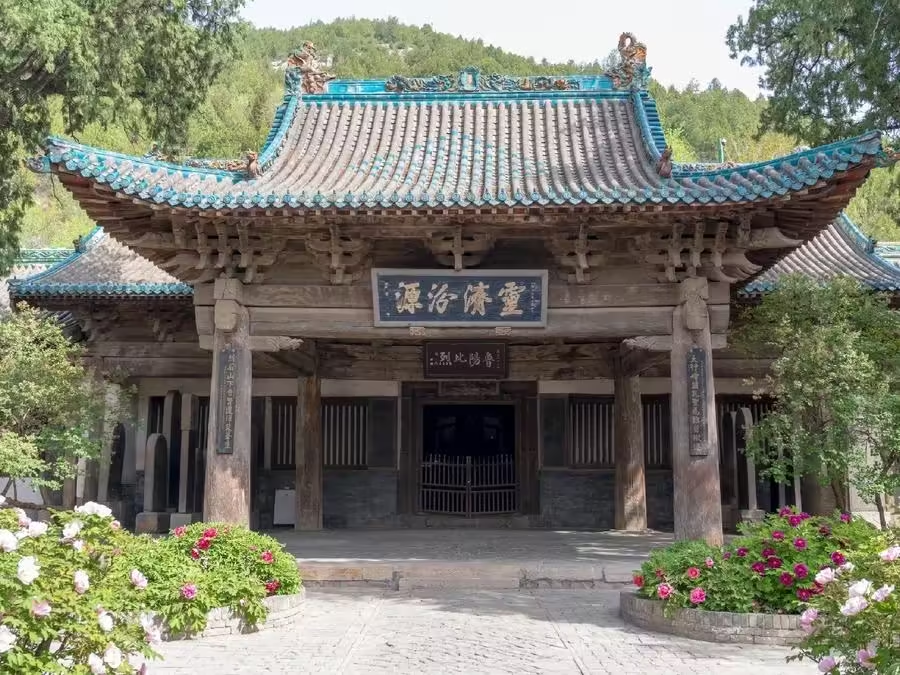Juewei Mountain (崛围山) is located in the outskirts of Taiyuan, Shanxi Province, and stretches in a north-south direction, with an elevation of around 1,400 meters. The mountain features two prominent peaks: Qingfeng Peak to the south and Feiyun Peak to the north. These peaks rise sharply, creating a deep valley running east to west between them, resembling a gateway to the mountains. From the summit, the surrounding peaks appear like rolling waves, forming a massive vortex that resembles an inverted trumpet or a large disc, which is how Juewei Mountain got its name.
Historically, Juewei Mountain has been covered in a forest of birch and cypress, and it is especially famous for its stunning autumn foliage. In deep autumn, the mountain transforms with a delicate veil of red, resembling clouds or mist. The expansive yellow reeds on the slopes are adorned with fiery red leaves that sway gently in the autumn breeze, creating a rustling sound reminiscent of burning trees. Even the white grasses at the base are tinged with a faint red glow from the reflection. At the summit, standing under the elegant Juewei Mountain Relic Tower, you can enjoy a refreshing and clear view, taking in the scenic beauty of JinYang.
Table of Contents
- Basic Information
- Location and Transportation
- Highlights of Juewei Mountain
- Vlog about Juewei Mountain
- Other Attractions in Taiyuan Suburbs
Basic Information
| Estimated Length of Tour | 2 hours |
| Ticket Price | Free |
| Opening Hours | 8.30 – 17.30 (1st April – 8th October) 9.00 – 17.00 (9th October – 31st March) |
Location and Transportation
Juewei Mountain is located 24 kilometers northwest of Taiyuan City, in the west of Huyan Village, Chaicun Town, in the Shanxi Province. To reach the mountain, take bus routes 12 (branch), 326, or 833 to Huyan Village stop (呼延村站). From there, it is about a 1.8-kilometer walk to the base of Juewei Mountain.
Highlights of Juewei Mountain
Duofu Temple

Duofu Temple is situated on Juewei Mountain. Established in 786 AD (the second year of the Tang Dynasty’s Zhenyuan era), it was visited by notable figures such as the Tang general Li Keyong and his son Li Cunxiao, both prominent during the Tang and Later Tang Dynasties. The temple was destroyed during the Song Dynasty due to war but was rebuilt during the Hongwu period of the Ming Dynasty (1368–1398) on the original site.
The temple faces south with its structures built from brick, tile, wood, and stone. Originally known for its grand scale and unique layout, it was referred to as the “True Three Courtyards” with nine courtyards in total, though only three courtyards remain today. The main entrance features a three-bay mountain gate flanked by statues of the Guardian Deities, Heng Ha Er Jiang, and the Four Heavenly Kings. Inside, the Great Hero Hall (Daxiong Baodian) is the central structure, featuring a grand seven-bay facade, five-bay depth, double-eaved gabled roof, and intricate wooden brackets. The hall houses three Buddhas and four Bodhisattvas, with a notable Ming Dynasty statue of the Avalokiteshvara, seated in a reverse posture. The hall’s walls are adorned with 84 murals depicting the life of the Buddha, intricately detailed with natural scenery.
Seven-Story Pagoda

On the southeast peak of Juewei Mountain stands the Seven-Story Pagoda, originally built during the Song Dynasty. Constructed from brick and stone, the pagoda base and platform measure approximately 17 meters wide and 21 meters long, with the tower itself reaching 25 meters in height. It features seven levels and a hexagonal shape with exquisitely detailed craftsmanship, resembling the top tassel of a warrior’s helmet. From the pagoda base, the panoramic view of Taiyuan City is striking, with modern skyscrapers visible in the distance, the shimmering Fen River below, and lush green banks, creating a serene and refreshing landscape.
Tutang Jingyin Temple

Tutang Jingyin Temple, also known as Dafosi (Great Buddha Temple), is located 8 kilometers east of Juewei Mountain in Tutang Village, and 7.5 kilometers north of Chaicun in the Jianchao Ping District. The temple is nestled against the mountain, with the Fen River to the east, surrounded by ancient cypress trees and dense foliage. According to the inscription “Rebuilding of Tutang Pavilion” from 1541 (the 20th year of the Jiajing era of the Ming Dynasty), a landslide in Han times created a cave with a soil mound reaching 10 zhang (a traditional Chinese unit of length), believed to be an apparition of the Buddha. This led the villagers to invite sculptors to create and decorate the cave, and a kiln cave was built.
In 1739 (the 4th year of the Qianlong era of the Qing Dynasty), another inscription was added, which also referred to the Buddha’s origins dating back to the Han Dynasty. Historical research indicates that the temple was initially constructed during the Northern Qi Dynasty, rebuilt in 1205 (the 5th year of the Jingtai era of the Jin Dynasty), and underwent several renovations during the Ming Dynasty. The temple features a pavilion with a cave that is 17.70 meters deep, 7 meters wide, and 12 meters high, built from brick and stone. Inside the cave, there is a 9.46-meter-high, 6-meter-wide clay statue of Amitabha Buddha seated cross-legged facing east. The statue is grand and majestic, showcasing superb sculptural skills with a blend of ancient Indian Buddhist features and traditional Chinese village aesthetics.
Duke Dou’s Shrine

Located 20 kilometers northwest of Taiyuan City, in Shanglan Village along the left side of the Fen River Gorge, Duke Dou’s Shrine sits at the base of Lishi Mountain, also known as Lishi Shrine. The shrine is surrounded by clear streams and ancient cypress trees, with grand and imposing architecture. Duke Dou Chou, also known as Mingdu, was a notable figure of the Jin State, who was granted land in Taiyuan and engaged in irrigation projects. A shrine was built here in his honor by later generations. The original shrine was submerged by the Fen River in June of the eighth year of the Song Yuanfeng era, and was relocated and rebuilt to the north. The shrine has been renovated over the years, with the existing gate, offering pavilion, and main hall rebuilt in the third year of the Yuan Zhizheng era (1343). Some parts of the structure still retain the architectural style of the Song and Jin Dynasties. The offering pavilion is notably large, with its rear columns replaced by the main hall’s corridor columns, showcasing a rare and refined structure in Jin and Yuan architecture. Adjacent to the shrine is a clear spring flowing from the cliffs of Lishi Mountain, known for its cold temperature, giving it the local name “Cold Spring.”







